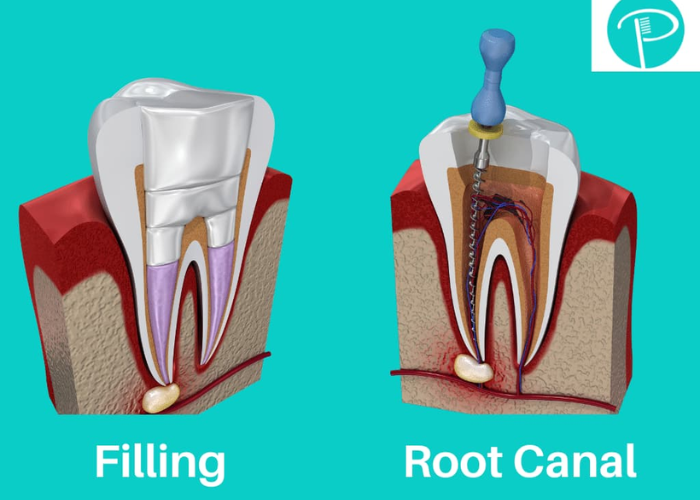Your teeth are an essential part of your body for a healthy life, but it’s a matter of time until you develop tooth pain and discomfort. Ninety percent of adults over 20 have had at least one cavity. What feels like a toothache could evolve into something more significant, and learning to tell the difference between a cavity vs. root canal is a step toward enlightenment and improved health.
Leaving your tooth pain untreated comes with significant health risks. Visiting your dentist is a wise decision, but some teeth are more challenging than others to inspect and diagnose.
Fortunately, you’ve discovered the perfect resource to determine if you need a cavity filling or root canal for your persistent tooth pain. Continue reading to learn more about each process and its benefits for your oral health today!
What Is a Root Canal Treatment?
A root canal is a treatment method dedicated to saving your natural tooth after discovering tooth pain and decay. It’s more cost-effective and less invasive than attempting to pull the tooth and replace it with a fixed denture option. Your root canal procedure involves the orthodontist cleaning and removing the dead tissue and pulp from the tooth.
They’ll then reseal the tooth with a crown to prevent further decay and damage to its interior. It’s the best path forward since your natural teeth are perfect for tasks like chewing food. The crown will also look more aesthetically pleasing than a fixed denture.
When you get a root canal treatment, you’ll protect the neighboring teeth from overuse and damage. The risks of getting a root canal are that your tooth could become weaker and less stable. You’ll also need to find time in your schedule to make multiple visits to the dentist for the procedure.
What Is a Filling?
Filling a tooth requires drilling out the cavity or decay and inserting a material into the vacant space in your tooth. It’s an effective way to overcome a cavity without an invasive procedure. The material is molded into the tooth to restore its natural shape and state.
Your filling will look natural in your tooth and prevent further decay as time passes. Fillings are a better option for repairing teeth after minor decay. They’re the best option if you’re working within a budget since they’re more cost-effective than root canals and fixed dentures.
The filling your dentist provides will protect your teeth from further decay. With luck and proper maintenance, you’ll avoid needing a root canal.
The risk involved with getting a filling is the possibility of degradation of the filling material. The best filling materials should last years, keeping your mouth and teeth healthy and happy.
What Are the Symptoms?
Determining if you need a cavity filling or root canal is confusing when you’re not an experienced oral health practitioner. The symptoms are similar, but there are minor differences you can use to determine the best treatment option for your teeth. Here’s a closer look at the symptoms to monitor if you’re concerned about tooth pain.
Filling Symptoms
The symptoms of a cavity that requires a dental filling include a throbbing sensation and sharp pain in the tooth. These feelings come to the forefront when eating or drinking. Most pain results during the process of chewing food during a meal.
The tooth with a cavity will also become more sensitive to hot or cold food or beverage options. You’ll see signs of minor dental decay when you look closer at the tooth under ample light.
Your floss snapping while in use is another sign that you have a cavity requiring filling. The jagged edge from the cavity is enough to fray through the floss and cause it to snap. Look for these signs and symptoms when you feel tooth pain and fear cavities.
Root Canal Symptoms
The primary symptom of root canal damage ranges from moderate pain and swelling to severe pain in the affected area of your mouth. Many patients also notice extreme sensitivity to hot and cold food and beverage options.
You should also monitor physical changes to the tooth if you’re worried that your toothache is a minor symptom of a much more significant health issue. Many people who require root canals notice physical changes to the affected tooth.
These changes could be dark spots or small holes. Severe cases could involve a loose or cracked tooth. Monitor these symptoms and schedule an appointment for a Complete Guide to Orthodontics.
What Is the Cost Difference?
In addition to the symptoms and pain you’ll experience with a cavity vs. root canal, it’s worthwhile to dive into the costs of each health procedure. Each case is different, but it’s a good rule of thumb to expect your root canal to cost more than a simple cavity filling. Here’s a deeper dive into the cost of each treatment option.
Root Canal Costs
A root canal costs between $1,500 and $1,900 per tooth. The price will vary by how much your insurance covers, the number of teeth the dentist works on, and how much dead pulp must be removed from the afflicted teeth. It’s the most expensive of the two treatment options.
Filling Costs
Fillings range in cost based on the material the dentist uses for the procedure. Gold and porcelain fillings are the most expensive options, with the price tag reaching $4,500 each.
Composite fillings are another popular option since they’re more affordable, and the dentist can match them to the natural color of your teeth. Expect each composite filling to cost between $250 and $400.
Know the Difference Between a Cavity vs. Root Canal
It’s your responsibility as an adult to make wise decisions for your health and take steps to maintain it, and that starts with knowing the difference between a cavity vs. root canal. Cavities involve minor damage and less invasive procedures to fix.
A root canal is best when there’s extensive damage and decay to your tooth. It’s the best way to save your natural tooth and avoid getting a fixed denture.
Your health is non-negotiable, and you must use the best tips to maximize your well-being for years to come. Learn more beneficial health tips from our engaging Health and Fitness blog posts today!




